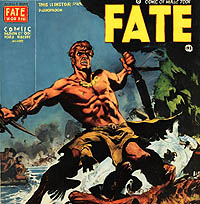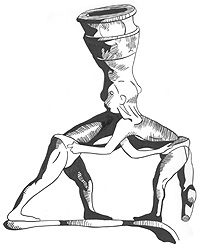Domination and exploitation pretty much explains everything. That’s why the lion is the king of the jungle and the alley cat begs for food. There is always someone who is more powerful and dominates the resources. The whole junkie class is designed to be exploited: dirty old men wanting sex, dealers wanting profits—two hundred years from now they might be saying look how they exploited all those junkies back in the 20th century. The game is rigged. Look, you see the pretty black girl and the white dude she’s with, their getting high, splitting the dope and going to the bathroom at the same time. She’s with him for the status and the dope. Of course, he wants the pussy.
There was a guy named Bear. He used to come into this bar, one of the biggest fences around. He lived up by Walther and Northern. Junkies from all over would come into his house in the middle of the night with stolen goods: lawnmowers, you name it and he would sell it down the North Point flea market. He eventually made tens of thousands of dollars, bought property up in Delaware. That’s just one example of how so much is based on drug addiction in this economy—call it a society if you want, it’s an economy first and foremost.
Dindu with Stilts
This was at the Homewood apartments for Johns Hopkins at Charles and Thirty-Second, a real old apartment complex that they bought and turned into student housing, a big brick apartment complex. I was doing drywall and framing. It’s the same principal whether wood or metal frame. You put a track down and then raise your studs against the wall. For fire code in any jurisdiction for commercial or multi-family work they try to use the least amount of wood as possible. Wood is pretty much used for single family homes and small apartment buildings.
Stilts are used to walk on so you don’t need scaffolding where you work. They tend to be used in residential—anywhere there are acoustical ceilings, drywall ceilings, for framing. You can walk around and do your framing. They are relatively expensive, easy to sell, so they’re something you have to keep an eye on on the jobsite.
I was with Centerline now, no longer working with Randy’s outfit. We come back from break and this guy notices his stilts are gone and we’re on the second floor. Some of the wall was open and we see the dindu out in the alley goin’ out with the stilts. These were all a bunch of Hamden boys [rough city hicks]. They took off and ran down there and caught him and they beat the holy hell out of him. Put his leg up on a dumpster and broke it with crow bar. It wasn’t much of a sound when they broke it. He done had his face kicked in, head tunred around. He was in bad shape. He made grunting and moaning sounds. The leg went up there and the guy brought the crow bar up over his head and hit him in the knee with the crow bar and his knee bent 90 degrees in the wrong direction—they fixed his ass. The police were called and he wound up being arrested because he had some warrants. He said he was attacked, but the guys that done did it had melted back into the job site. It was a big job. When the cops came they said they had nothing to do with it and said they didn’t know nothin’. He was in bad shape. They got him conscious in the ambulance. The important thing is none of the workers got arrested. He’s lucky he didn’t get hit in the head with that crow bar.
The Dindu Drywall Man [age- 21]
This guy and his wife had a little construction company and were renovating and selling, but also renovating and renting out to recovering drug addicts as halfway houses—another junkie-based racket. The wife’s sister was a lesbian. They were getting some kind of money from the government. Randy had a crew cut, had no fuckin’ neck, huge muscle-bound weightlifter, a good six-two and three hundred pounds of muscle. Looked like a pro wrestler guy. He had this one dindu working for him, not real dark but a dark brown, not one of the blue-black dindus you see on construction sites, but a chocolate colored guy. He said he was a drywall finisher. This was his first day on the job, doing a house on Highland and Baltimore, next to Mister Joe’s Tavern one door off that alley right there.
They hired him and told me to keep an eye on him, let’s see if he knew what he was talking about. The first couple hours he was doing all right. Then we take our break at nine and he disappears a little after ten during his fifteen minute break, left his stuff on the job. This kook comes back and I say something to him and he mumbles something, goes down into the basement and he takes a cardboard box like a shower unit comes in and he sits in this box and I go down and knock on the box and ask him if he’s alright. He grunts and I can’t make out what it was. I called Randy and he came right over from his office on Lombard Street where Santonies was and told him he best check his man out.
He goes down, rips the box off of him and the dindu is sittin’ there on a bucket with a bottle of vodka and a crack pipe. He throws the guy out the house, runs him up the steps and out the door and says, “Get out, you’re fired.”
The guy comes back in and tries to get to his stuff and him and Randy get into a pushing match and Randy picks him up and slams him on his head right in the middle of Highland Avenue. I got his stuff and gave it to him and the dindu went limping down Highland Avenue. That was the end of the dindu drywall man.
Housing Structures in Baltimore
In that same block they had three houses we were redoing. One they sold and the other two they turned into recovery houses. The one house they gutted out and found all these dog bones in the walls. Someone cut a dog up and put dog parts in these walls. They said these homes were built in 1902 or 1906. It was probably a disgruntled worker, because I know someone who sealed a bunch of crab shells up in a wall. Crab shells stink terrible and stuck them in a wall and sheet rocked over them—this was in an apartment complex in Hunt Valley. People actually moved in and started complaining about the wretched odor. They tried doing a remedial fix and finally we had to cut the walls open and we found a trash bag full of crab shells. It was a condo that somebody bought. So that’s probably what the deal was with the dog.
These Highlandtown Houses were about fourteen feet wide. I’ve seen them anywhere from ten to eighteen foot. But twelve to fourteen foot is about average. Down there in the alley streets like in Pig Town they were built for poor people, two stories and about forty feet. The length changes from street to street, anywhere from thirty-two to fifty feet. On the main thoroughfares houses were longer and usually three stories. The way they designed then is your income or class changed from street to street. The main thoroughfare houses are for the wealthy, the next block back is for the working guy and the alley street is for the poor.
South Baltimore had carriage houses. I renovated a carriage house about a block over from Broadway on Ann and Pratt—around there—that we basically turned into a recreation space for the home owner. Drywall and sheet rocks is the same thing. Sheet rock is just a brand name—a very old company, USG company and then it became slang for any drywall like Kleenex is for facial tissues.
Now plaster, up until the early 1900s and into The Depression it was done with lime. The way they mixed it was different, but it was basically the same as brick mortar. They’d mix lime and horse hair for the base coat. Then lime and sand for the second coat, which was the brown coat. Then there was the third coat which was lime with an aggregate, like fine silica sand or marble dust for a slick finish. In the early Twentieth Century they went to a gypsum plaster, which was faster to do. Horse hair was plentiful until the car became big [horse hair was used to stuff boxing gloves up until the 1970s]. They would use other types of hair too, whatever was common in the area. Them old row homes stood the test of time. They are poorly insulated but being together as they are the houses help insulate one another. It was traditional thing—still done in parts of Baltimore—where people in the wintertime live in one room and the rest of the house settles to a natural temperature, just enough so the pipes wouldn’t freeze. Doing that in a big single house you might have your pipes freeze.
Composition Notes
Theft, hazards, workplace politics and conditions on ever larger jobsites will be covered in Chapter 8, with Chapter 9 devoted to Ron's adult life outside of work. Chapter 10 will present his parting view of Baltimore as it stands, including what he knows of the fate of his childhood friends. The book photos by Mescaline Franklin are in and will be footnoted throughout the printed book.
Being a Bad Man in a Worse World
Fighting Smart: Boxing, Agonistics & Survival











I like these stories, they're interesting.
Great stuff, again. Typos to correct:
"He done had his face kicked in, head tunred around. "